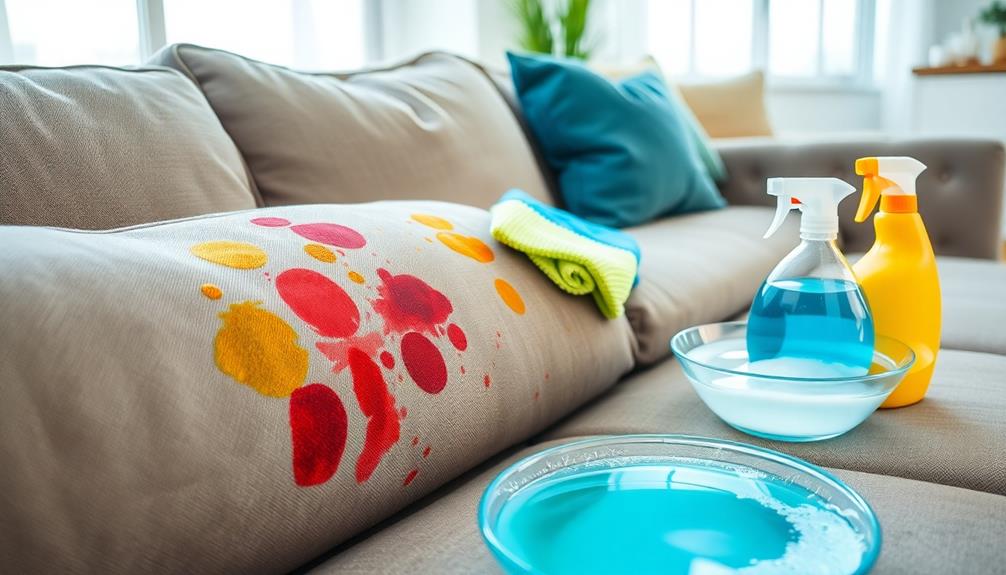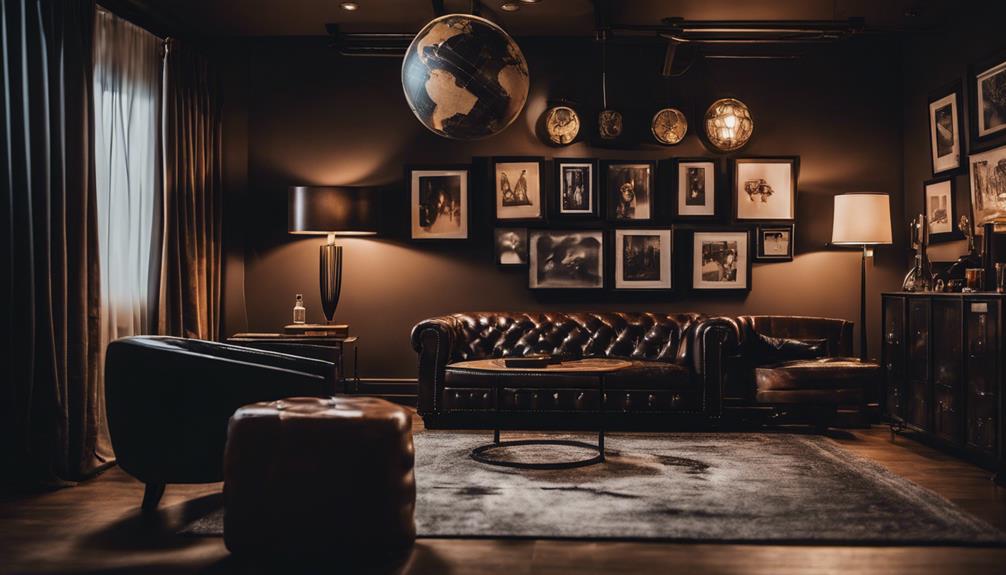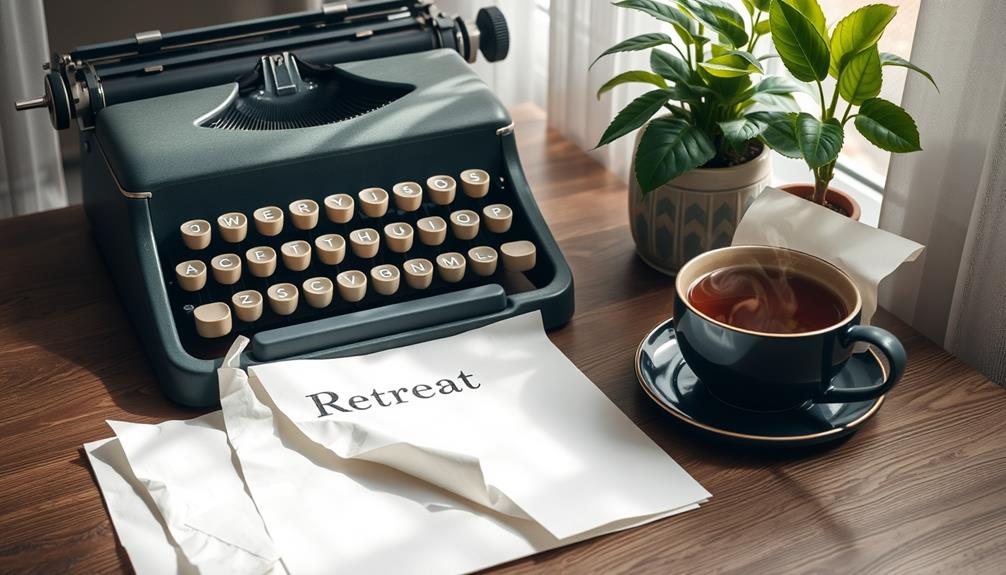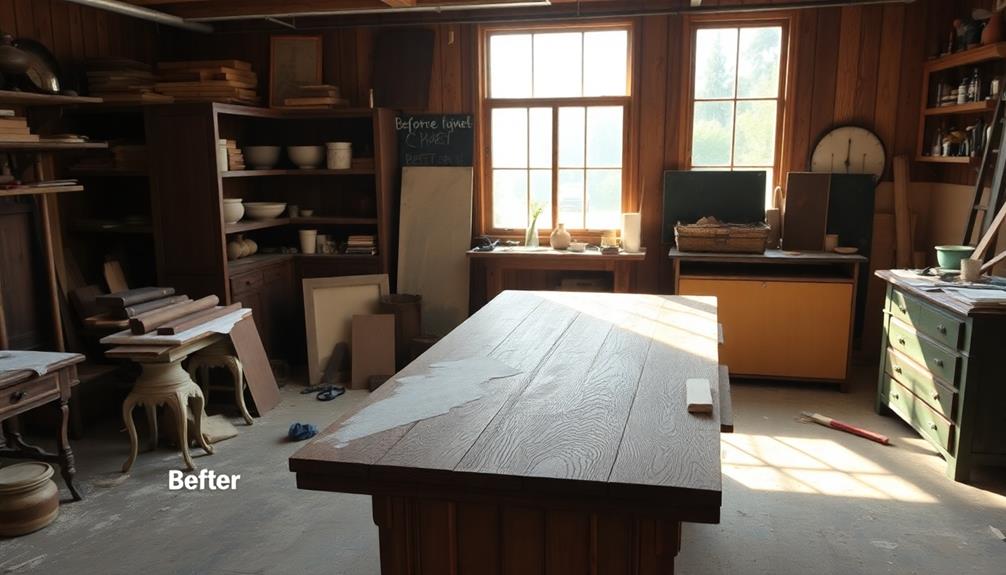To get rid of stains on your fabric sofa, it is important to act promptly in order to prevent further damage. Start by checking the care tag for cleaning instructions and gather supplies like mild dish soap, vinegar, and baking soda. When dealing with fresh stains, remember to gently blot with a clean cloth instead of rubbing. The dish soap and water method is effective for many stains, while a baking soda paste can help eliminate odors. It is crucial to use tailored techniques for specific stains such as pet urine or coffee. Regular maintenance, such as vacuuming, can help prevent future stains. For more effective sofa cleaning techniques and tips to keep your furniture looking fresh and inviting, consider exploring further options. Additionally, steam cleaning can be a great option for deep cleaning and removing stains from a sofa. Always test any cleaning solution on a hidden area before treating a larger spot. Investing in a fabric protector spray can also make it easier to remove stains from a sofa in the future by creating a barrier against spills and dirt. Stubborn stains may require repeated treatments to fully remove without harming the fabric. When cleaning couch stains, be sure to use gentle products and techniques to avoid discoloration or wear on the material. Lastly, consistent upkeep like wiping down and vacuuming your sofa regularly can help extend its lifespan and maintain its appearance.
Key Takeaways
- Act quickly to treat stains, as fresh stains are easier to remove and prevent deeper penetration into fabric fibers.
- Always check the fabric care tags for specific cleaning instructions and appropriate cleaning codes before proceeding.
- Use non-toxic cleaning solutions like dish soap, vinegar, and baking soda tailored to the type of stain for effective removal.
- Perform spot tests on hidden areas to ensure cleaning solutions won't damage the fabric before full application.
- Regular vacuuming and spill awareness can help prevent stains from embedding into upholstery, maintaining your sofa's condition.
Importance of Quick Action
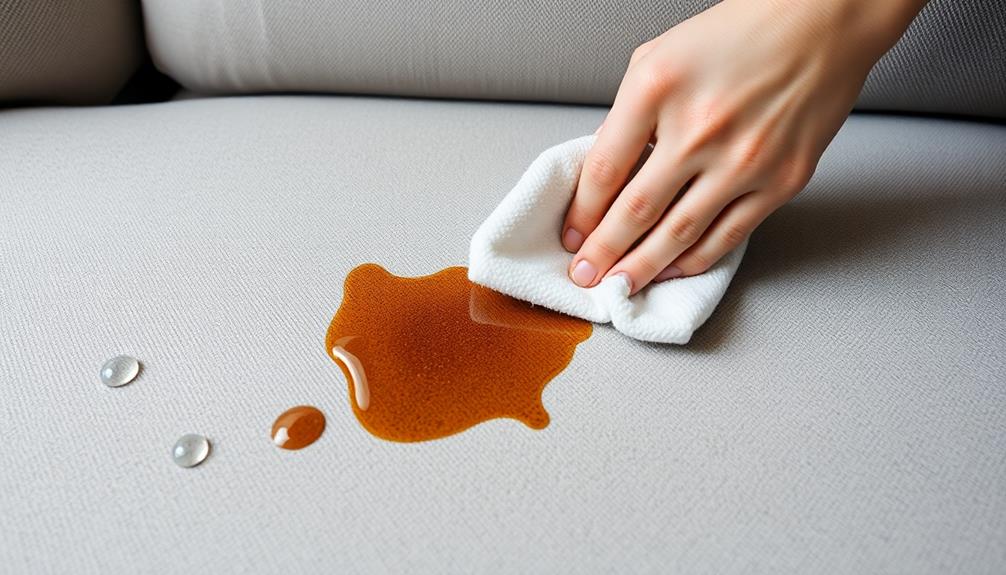
When it comes to fabric sofa care, quick action is your best friend. When you notice a stain, don't hesitate; tackling it immediately can make all the difference. Stains can penetrate deeper into fabric fibers over time, turning simple cleanups into complicated, time-consuming tasks.
Regular maintenance, much like air purifier upkeep, can also enhance the longevity of your furniture. The sooner you act, the higher the chances are of complete stain removal. Fresh stains typically respond better to your cleaning solution, so the clock starts ticking the moment the spill happens.
If you delay treatment, you might find yourself needing stronger cleaning solutions or even professional help, which can be a hassle and a drain on your wallet. Having a DIY cleaning kit ready to go can empower you to address stains promptly, ensuring you're always prepared.
Preparation Steps
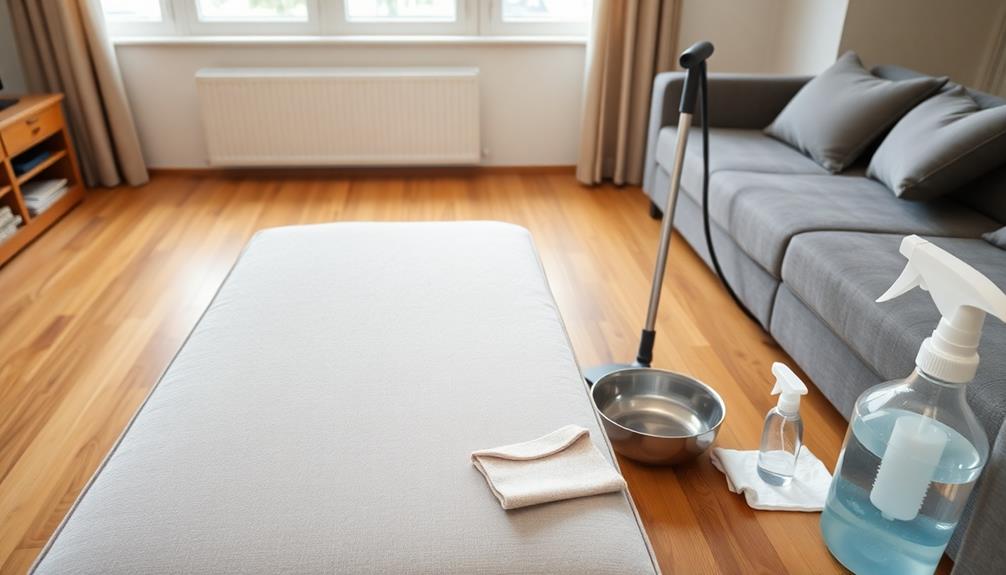
Before you start tackling stains, check the fabric care tag on your sofa to determine the right cleaning methods.
It's also helpful to contemplate using natural solutions, such as essential oils for cleaning, which can enhance your efforts.
Next, gather your cleaning supplies, including items like vinegar and baking soda, so you're ready when an accident happens.
Being prepared will make the cleaning process much smoother and more effective.
Check Fabric Care Tags
Checking the fabric care tags is essential for effective stain removal from your sofa. These tags provide important information on the appropriate cleaning methods for your specific fabric. Look for cleaning codes like W (water), S (solvent), S/W (both), and X (vacuum only). Understanding these codes prevents damage, as using the wrong cleaning solution can lead to discoloration or deterioration of the upholstery.
Additionally, just as a personal budget is significant for financial health, knowing your fabric's care instructions is key to preserving its condition.
When dealing with vintage or untagged pieces, it's wise to perform a spot test in an inconspicuous area. This way, you can gauge how the fabric reacts to various cleaning agents without risking visible damage. The care tag often includes specific washing or cleaning instructions that you must follow to maintain the fabric's integrity and appearance.
Ignoring the guidance provided on care tags can lead to ineffective cleaning or even worsen existing stains. By taking a moment to check these tags before you start, you'll set yourself up for success and protect your sofa from potential harm.
Gather Cleaning Supplies
To effectively tackle stains on your fabric sofa, gather the necessary cleaning supplies first. Start with a clean, dry cloth, which you'll use to blot stains without spreading them. You'll also need mild dish soap, white vinegar, and baking soda for your stain removers. A spray bottle is handy for mixing and applying your cleaning solutions.
Additionally, having a vacuum cleaner ready is vital; for instance, consider using one of the best vacuums for dust removal in 2024 to guarantee your sofa is free from loose dirt and debris before addressing any stains. This step is essential for effective upholstery care. A stiff brush can be beneficial for scrubbing away stubborn spots that resist simple cleaning methods.
If you're looking for deeper cleaning and odor removal, consider using a handheld steam cleaner. This tool can be particularly effective for fabric sofas, assuring a thorough cleanse.
Cleaning Techniques
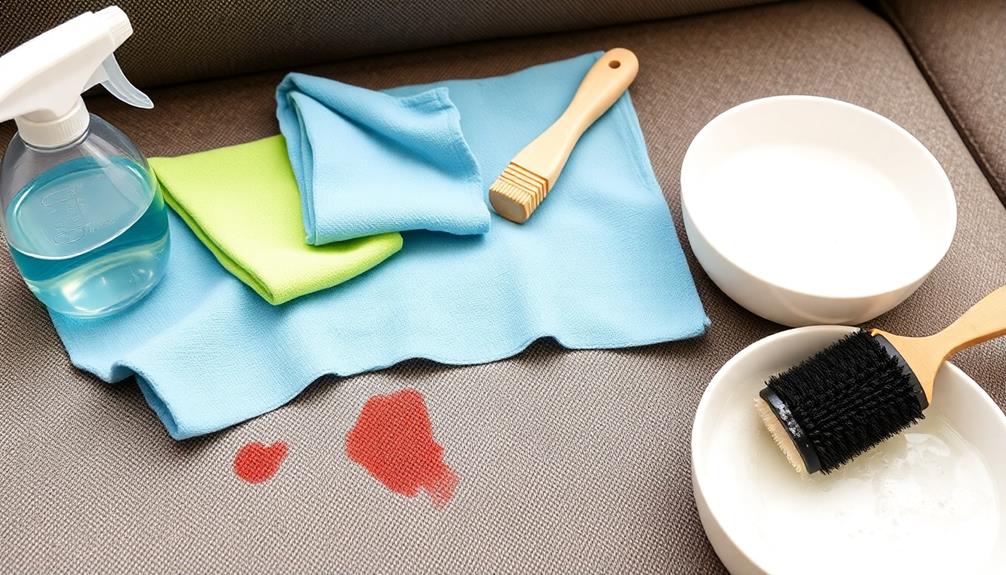
When it comes to cleaning your fabric sofa, using the right solutions is key.
You'll want to tailor your approach based on the type of stain you're dealing with, whether it's grease, water, or something tougher.
For instance, using non-toxic cleaning solutions can be effective and safe for your home environment, much like home remedies for grout cleaning.
Let's explore some effective cleaning techniques that can help restore your sofa to its original glory.
Effective Cleaning Solutions
There's no need to panic over stains on your fabric sofa; effective cleaning solutions are at your fingertips. For upholstery cleaning, start with the dish soap and water method. If your sofa has a cleaning code of W or S/W, mix clear dish soap with cool water, gently blot the stain, and let it dry completely.
Additionally, maintaining a clean living space can prevent dirt and stains from becoming embedded in your upholstery, which aligns with the importance of regular appliance upkeep in a well-maintained home preventive maintenance benefits.
Another powerful stain removing solution is a baking soda paste. Combine baking soda with water, apply it to the stain, let it sit for about 10 minutes, then vacuum the residue to eliminate odors and stains.
You can also try a vinegar and dish soap solution. Mix three parts warm water with one part vinegar, dab it onto the stain, rinse, and blot dry. This tackles various stains without harsh chemicals.
If the stain is particularly stubborn, consider steam treatment. Use a handheld steam cleaner or your iron's steam function to loosen set-in stains, making them easier to clean.
Before applying any cleaning solution, always conduct a spot test on an inconspicuous area of the fabric to verify compatibility and protect your upholstery.
Stain-Specific Techniques
Tackle specific stains on your fabric sofa with targeted techniques that can restore its appearance.
For pet urine stains, immediately blot with an absorbent towel. Use an enzyme-based cleaner to break down uric acid, and rinse with cold water to remove odors.
When dealing with coffee stains, quickly absorb excess liquid, rinse with cold water, then apply a mild detergent mixed with warm water for effective cleaning. It's important to maintain cleanliness and hygiene in your environment to prevent any additional staining, similar to how piercing care and hygiene are essential for healing.
For oil-based paint stains, gently scrape off excess paint and use a water-free solvent like acetone to blot the stain. Always test on a hidden area first to prevent damage.
Ink stains require isopropyl rubbing alcohol applied to the affected area, followed by washing with a mixture of dishwashing detergent and warm water to fully remove the ink.
Lastly, for grease stains, sprinkle baking soda to absorb the grease and let it sit for 20 minutes. Vacuum it up, then use a mixture of dish soap and water to clean the area thoroughly.
Each of these stain-specific techniques can help you effectively remove stubborn stains and keep your fabric sofa looking fresh.
Stain-Specific Methods
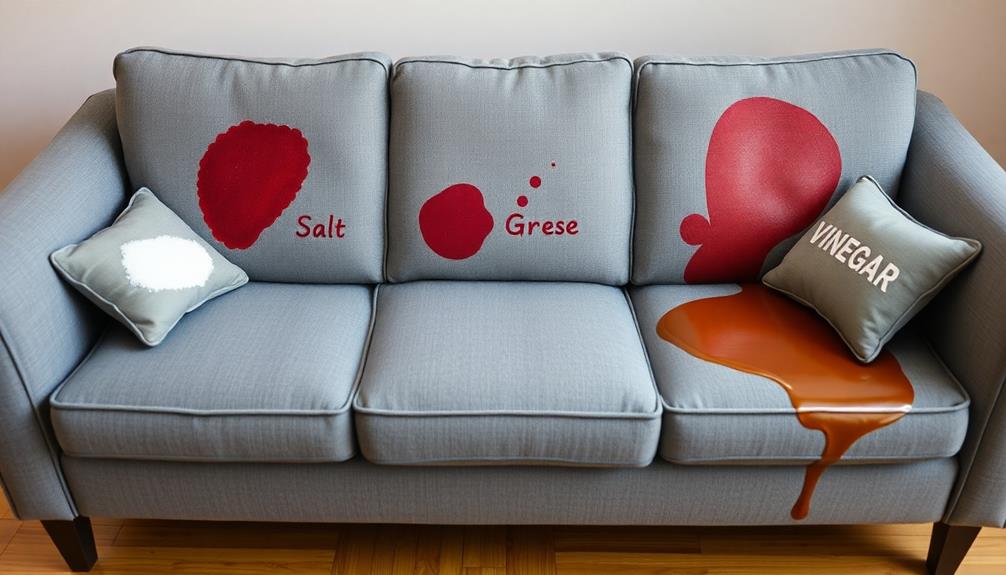
Removing stains from a fabric sofa requires specific approaches tailored to the type of stain.
For pet urine, start by blotting the stain with an absorbent towel to remove excess liquid. Then, apply an enzyme-based cleaner as your cleaning solution to break down uric acid crystals, ensuring you rinse and dry the area thoroughly to prevent lingering odors. It's also important to regularly check for signs of damage or wear on the fabric, as this can affect cleaning methods and overall maintenance. For additional care tips, refer to proper diet and care.
If you're dealing with coffee stains, quickly absorb any excess coffee with a clean cloth. Rinse the area with cold water and use a mild detergent mixed with warm water to clean the stain, repeating this process for stubborn stains.
For oil-based paint stains, carefully scrape off any excess paint without rubbing. Apply a water-free solvent, like paint thinner, testing it on a hidden area first. Rinse with cold water if the fabric allows.
Ink stains can be tackled by blotting the stain with isopropyl rubbing alcohol, then washing the area with a dishwashing detergent and warm water mixture. Rinse thoroughly to remove any remaining cleaning solution.
Lastly, for greasy stains, sprinkle baking soda to absorb the grease, let it sit for 20 minutes, then vacuum and treat any remaining stain with a dish soap and water solution.
Professional Cleaning Options
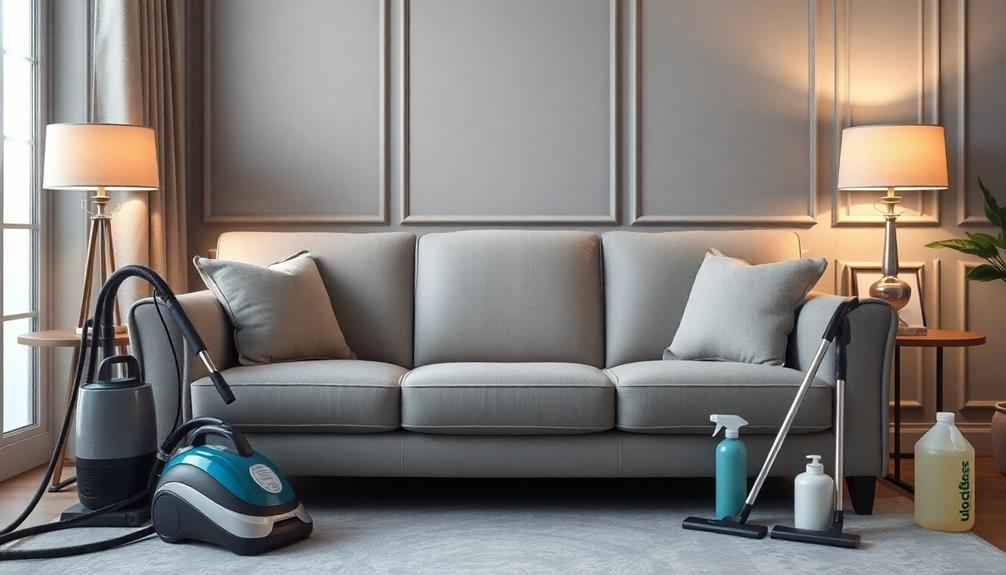
When your fabric sofa faces tough stains that just won't budge, considering professional cleaning options can make a significant difference.
Professional help is invaluable, especially for valuable or delicate fabrics, as experts use advanced techniques like steam cleaning and specialized cleaning products that you mightn't find in stores. Additionally, understanding the importance of selecting the right cleaning method can enhance the effectiveness of the stain removal process, much like how cold medications overview emphasizes choosing the appropriate remedy for relief.
Typically, upholstery cleaning services charge between $100 to $300 for standard fabric sofas, and high-end materials like suede may cost up to $500. Many cleaners offer custom contracts tailored to your specific stain removal needs, ensuring personalized care for your sofa. This is particularly useful if you've tried using common household items without success.
It's advisable to consult local upholstery cleaners for an assessment, especially for tough stains that resist DIY methods after multiple attempts. They can determine the best approach to avoid damaging your sofa while effectively removing stains.
Preventative Measures
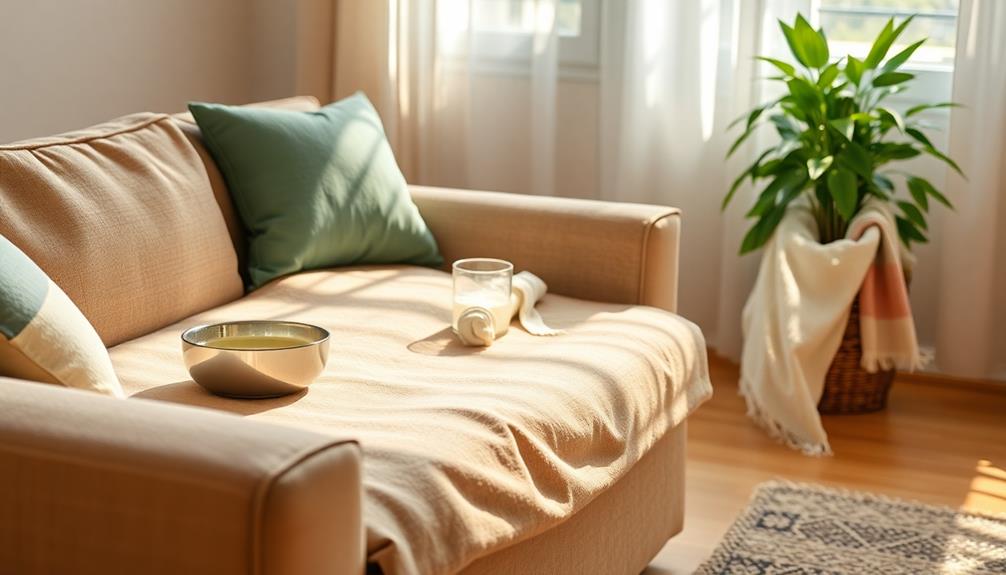
Maintaining your fabric sofa's pristine condition is just as important as knowing how to address stubborn stains. One of the best preventative measures you can take is to vacuum your sofa at least once a week. This helps to remove dirt and crumbs before they embed in the upholstery, which can lead to stains over time.
Additionally, incorporating gentle stretching and relaxation techniques, similar to those used in yoga for back pain, can help reduce the stress that may lead to unintentional spills.
Applying upholstery protection sprays creates a barrier against spills and stains, greatly reducing the likelihood of permanent marks. Make sure everyone in your household understands the importance of avoiding spills and addressing any accidents promptly. This collective effort goes a long way in keeping your sofa looking its best.
Additionally, keeping a cleaning kit with essential stain removal products easily accessible allows you to take immediate action when spills occur, minimizing the chance of stains setting in.
Finally, consider using slipcovers or throws. They add an extra layer of protection against stains and make it easier to clean or replace when necessary.
Understanding Upholstery Tags
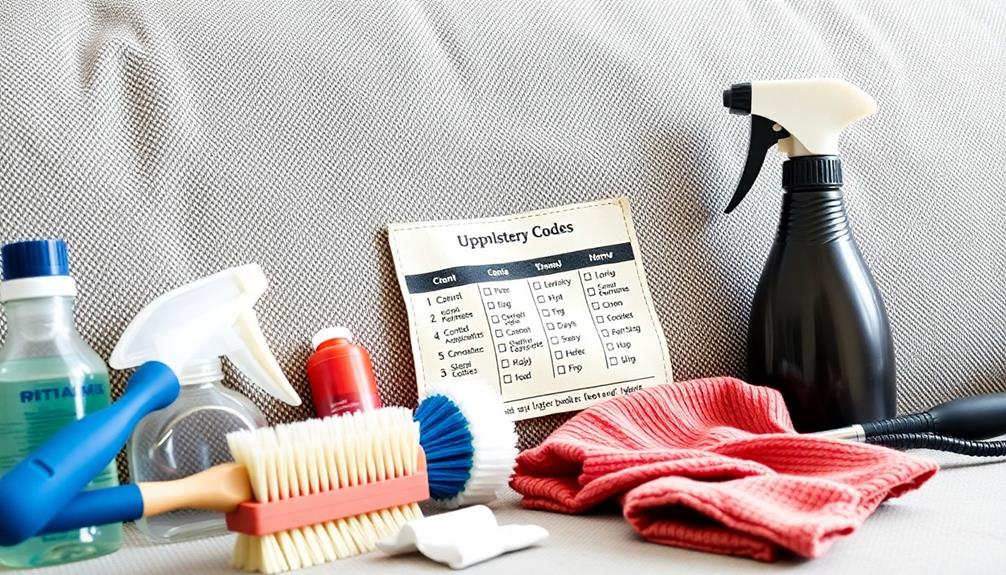
Understanding upholstery tags is vital for anyone looking to keep their fabric sofa in top shape. These tags provide essential cleaning codes that guide you in choosing the right cleaning method. Using the wrong technique can damage your fabric or fail to remove stains effectively.
Here are some common cleaning codes you might find:
- W: Clean with water
- S: Clean with a solvent
- S/W: Clean with water or solvent
Be sure to check these upholstery tags before starting any cleaning process. Ignoring these instructions can lead to discoloration or degradation of the fabric.
If your sofa is vintage or custom-made and lacks a cleaning code, perform a spot test in a hidden area before using any cleaning solution.
If the care tags are missing, don't hesitate to contact the manufacturer for guidance. They can advise you on the best cleaning methods.
When in doubt, you might also consider hiring a professional upholstery cleaner to guarantee your fabric is treated properly without risking damage.
Frequently Asked Questions
How Do You Get Tough Stains Out of a Fabric Couch?
To tackle tough stains, mix washing-up liquid, vinegar, baking soda, and warm water. Apply it directly, let it sit for 10 minutes, and then blot with a clean cloth to lift the stain effectively.
Can Old Stains Be Removed From Sofa?
Yes, you can often remove old stains from your sofa. Quick action is essential; try household solutions or steam treatments. If those don't work, consider professional cleaning for valuable or delicate fabrics.
How Do You Get Dried Stains Out of Upholstery?
To get dried stains out of upholstery, start by vacuuming the area. Then, apply a mixture of dish soap, vinegar, and warm water. Let it sit, blot, and repeat if necessary for stubborn stains.
Does Baking Soda Remove Couch Stains?
Yes, baking soda can remove couch stains. Sprinkle it on the stain, let it sit for 20 minutes, then vacuum. For tougher stains, mix it with water or vinegar for better results. Always spot test first.
Conclusion
Just like a gardener tending to a wilting plant, your fabric sofa needs your care to thrive. By acting quickly and using the right techniques, you can nurture its beauty and prolong its life. Remember, every stain is a story waiting to be told, but with a little effort, you can guarantee those tales are of triumph rather than despair. Keep your sofa vibrant, and it'll continue to be a cherished part of your home's landscape.
